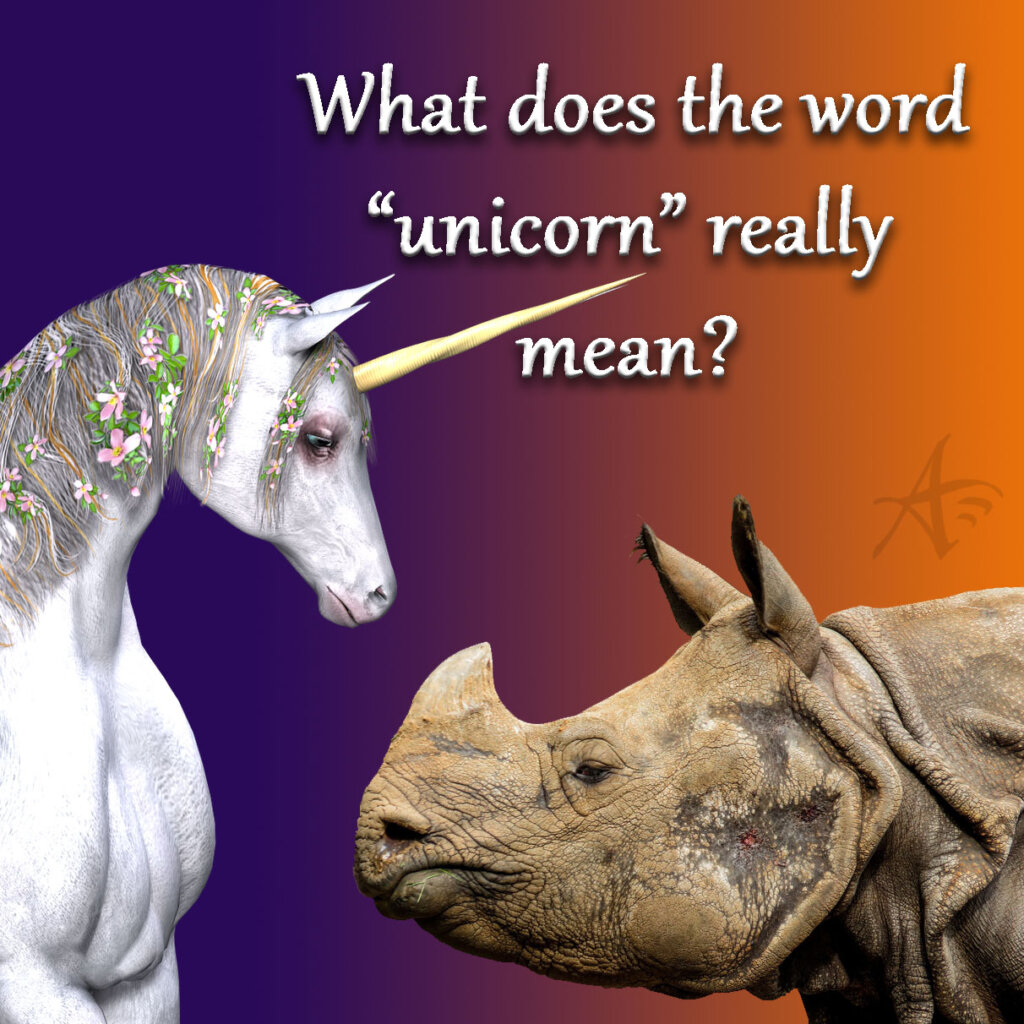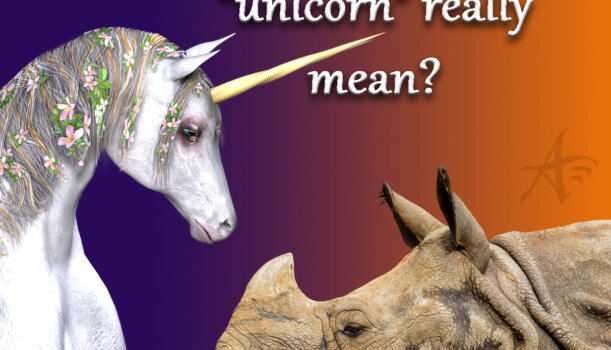Where does the word “unicorn” come from, and why are there so many different types and interpretations of what a unicorn is?
In this series about the meaning of the unicorn, we’ve talked with literary research expert Dr. Jane Beal about the links between the unicorn and the Bible and the forgotten Christian symbolism the unicorn embodies.[link] But how did the word “unicorn” end up in the Bible in the first place, and why is the current image of a unicorn so different from ones in the past?
In today’s post, we’ll explore those questions, but first, let’s take a quick peek at how Christianity and literature have interacted over time to give rise to this rich unicorn symbolism.
How Christianity shaped English literature as a whole
Q: How else do you see faith and literature interacting and shaping each other?
Oh, I mean, it’s continual. Like from the beginning of literature in English. Because literacy, for example, came into England because of Christian missionaries, so the most that the Angles and the Saxons and the Jutes and Vikings had was runes, like a runic alphabet, and we have some runic literature that survives, but mostly we have Christian literature that survives because Christianity brought literacy; they brought the alphabet.
And in consequence, from its very origins, literature in England had an integration with the Christian faith, and it continued as it diversified. So Christianity was essentially Catholic, first Irish Catholic in England and then Roman Catholic. So the Irish were missionizing the northern part, evangelizing the northern part of England, and then Pope Gregory sent Augustine—not Augustine of Hippo, but a later Augustine—to England to evangelize in the southern part where the Angles and the Saxons were. And so there were conversions, and it resulted in integration of faith and literature ever since then. And it diversified from there. The Catholicism diversified as Protestantism came in with the Anglican Church with King Henry VIII, and then of course Anglicanism was reformed from within with the Puritans, and you get all the varieties of Christian denominations.
And so basically, literature would go along different lines depending on what’s influencing it more, which aspects of religious denominationalism are influencing it more. And so now, of course, we have a very wide and deep literature that’s primarily secular, but if you do know something about Christianity, Christianity often touches even the most mainstream secular literature because it’s so deeply embedded in the history and the culture of English literature, or literature in English, since now basically English is worldwide.
How the unicorn’s meaning changed over time
Q: That’s a great history that we have to draw on. I’m curious, as you were researching these symbols of Christ and these different creatures, how has your research changed your outlook or your faith?
Well, one thing that is really cool is that I do get to talk about unicorns in a different way than they are talked about in the mainstream culture. So, for example, “unicorn” has become almost synonymous with something that doesn’t exist or is extremely rare. So in science, they might joke about, “Well that’s a unicorn.” You know? Like that doesn’t exist.
But when I talk about unicorns, I’m talking about something with a rich Biblical, cross-cultural history, and it’s just very exciting in a way, to be able to redeem, in a sense, something that has been lost to our current cultural understanding. So you bring it back. And it’s really amazing to realize that the unicorn you see today in My Little Pony, for example, a children’s story, is a unicorn that has a much nobler history. The nobility of the unicorn is still portrayed in fantasy literature, like Peter S. Beagle’s The Last Unicorn where he draws on the legend of Amalthea from the Latinate mythological tradition. But you also see the nobility of the unicorn in C.S. Lewis; you see the nobility of the unicorn in J. K. Rowling, where unicorn blood transfers a kind of extended life or immortality to someone; and that is all in touch with the deeper unicorn symbolism that we find in the Middle Ages where the unicorn stands for Christ.
Etymology of the word “unicorn”
Q: What would you say was the most intriguing or meaningful nugget or aspect you found in your research about unicorns?

This might sound funny, but it’s actually the linguistic aspect that brought me such a sense of insight and relief. So, for example, “unicorn” literally means “one horn”, an animal having one horn. Which is why if you work back through the commentaries on the Bible passages that reference the unicorn, such as for example the Glossa Ordinaria from the Middle Ages, you’ll find the word “monoceros,” which is Greek for “one horn,” and also “rhinoceros.” So the unicorn is an animal that has one horn.
And the way we picture the unicorn today is as a horse with one horn, but what it may have meant in the Biblical passage may have more to do with the rhinoceros or any other animal that has one horn, and there’s also some passages in the Bible that deal with a goat, and so sometimes you’ll see a goat in an altar cloth with one horn that is the unicorn. And you’re like, “We think of a unicorn as a horse with a horn,” but sometimes you’ll see a goat with one horn, and it’s supposed to represent Christ in these altar cloths, and you’re like, “How is that possible?” And it’s possible because of the passages that get commented upon in the tradition that are variously read as either a one-horned animal, like a horse with one horn, or a goat with one horn or a rhinoceros. And a rhinoceros is a very different animal, isn’t it, than what we picture.
So what happened over time is that the animal that was being described changed. They all had one horn, but they were different animals, but…the same word was still being used to describe them, and they all had one horn. And once I could understand the progression in time and the way that the word could be applied in different ways to different creatures, it brought me a sense of relief and understanding of what had happened with the language change. Seeing the translations from Hebrew to Greek to Latin to English and how what’s being described could change from a rhinoceros to a goat to a horse so when you get to the early modern period and everybody’s like, “Why do we still have this word ‘unicorn’ in the Bible? A horse with one horn probably never existed.” And technically, they’re right, but what was being described originally in the Bible as “one horn” was probably never a horse with one horn. It might have instead been a rhinoceros.
Q: That’s very interesting. So you were able to synthesize these very different words, very different symbols, and trace them back to the same origin.
So the word is always the same, but what people think the word stands for changes. So it’s always, you know, “monoceros”, “unicornis,” “unicorn,” “anhyrne” in German—it’s always “one horn.” But the thing is, is that there were no rhinoceroses in England. They just knew about them from Africa and from pictures, and pictures could change… So imagine you’ve never seen. You don’t know what the “one horn” looks like that you’re reading about in Scripture. Is it a one-horned horse? Is it a one-horned goat? Is it a one-horned creature of another kind? What do you do? You paint or you stitch or you draw your best guess. And so this is why you see such a diversity in representations of unicorns in the Middle Ages.
Significance of the unicorn
Q: Do you have any other final thoughts that you want to share before we wrap up this interview portion?
Just that the unicorn is a very beautiful symbol for Christ and for Christ’s incarnation and His crucifixion, and if we resurrect that significance in our own day by looking at what we have inherited from the past, I think our lives will be enriched as educated people and as people of faith.
The unicorn’s special meaning still remains
We’ve seen how Christianity greatly advanced English literature and how the translations of ancient texts into English affected the image of the unicorn. It may have once been a real creature like a rhinoceros, goat, or deer with one horn, but over time it has become the enchanting horned horse that we see all around us in modern literature and pop culture. The understanding of the unicorn as a symbol for Jesus Christ has faded, but the essence of original meaning of the unicorn—that it is something rare, pure, and brings healing and restoration—has remained over time.
The unicorn is merely one of many fantastical creatures with special meaning. Come back for our next installment to discover the truth behind other favorite creatures!
The unicorn’s image continues to change. What’s your favorite version? Share below!
The True Meaning of the Unicorn Series
1. Introduction: About Dr. Jane Beal
2. What does the Unicorn Mean?
3. How did the Unicorn Change Over Time?
4. What do Other Mythological Creatures Mean?
Please review the Posting Policy before commenting.


